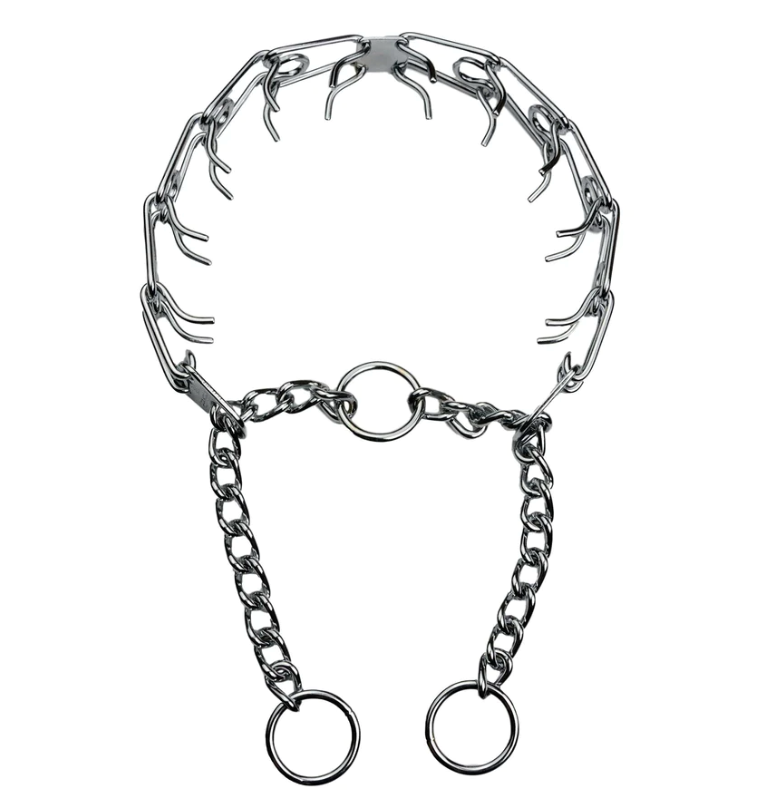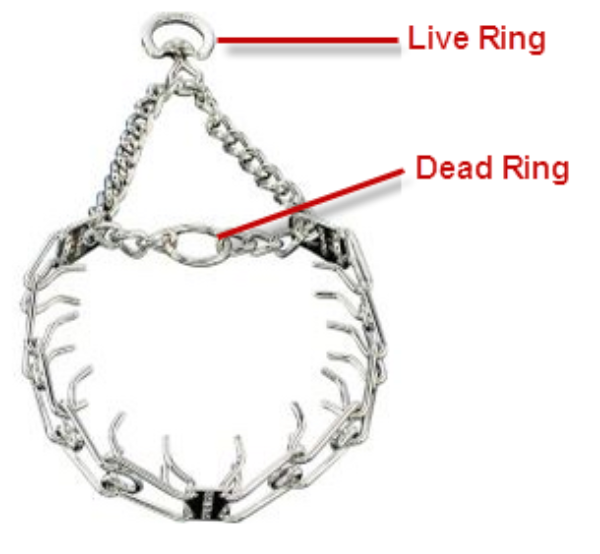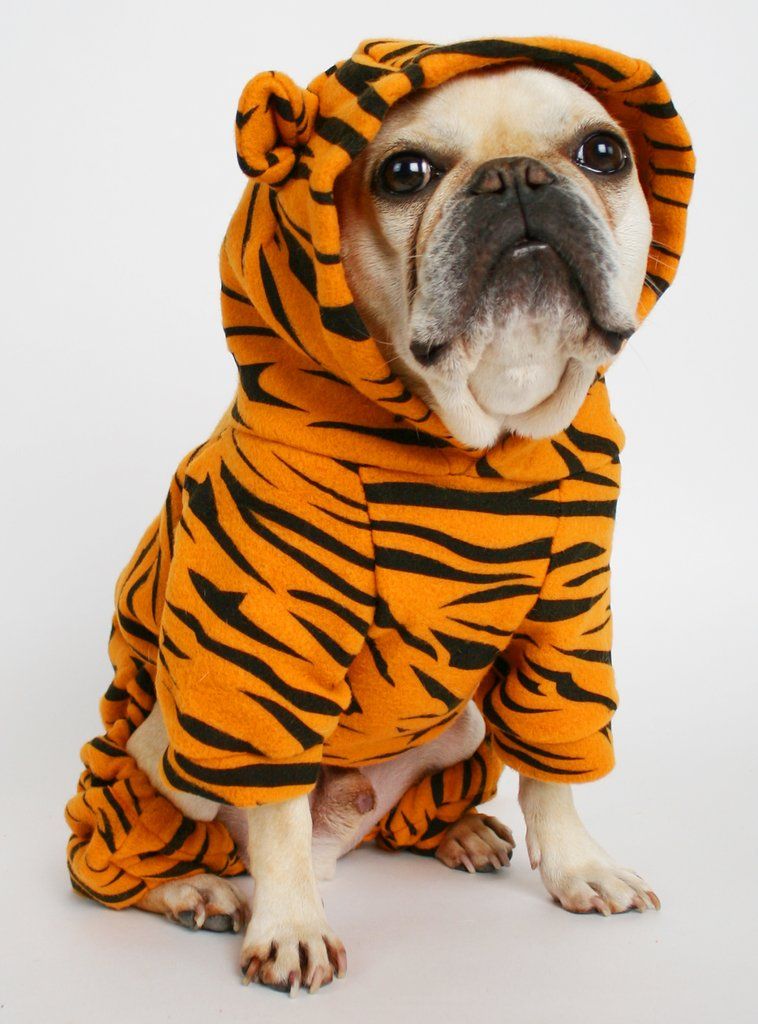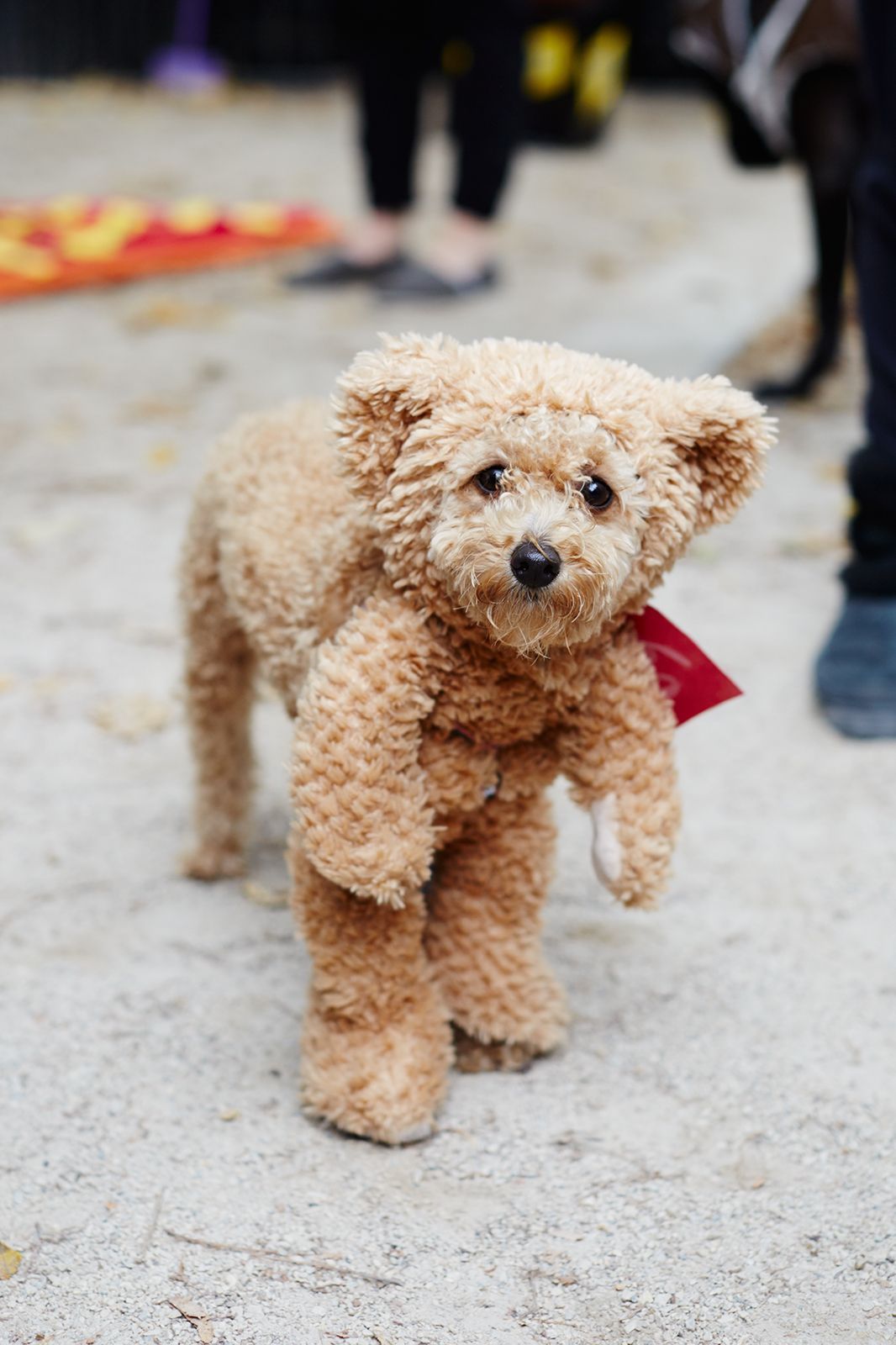A prong collar, also known as a pinch collar, is a type of dog collar that is commonly used for training and behavior modification. While prong collars can be effective in correcting certain problematic behaviors in dogs, they must be used correctly and responsibly in order to avoid causing harm to the dog.
In this article, we will discuss the proper way to place a prong collar on a dog and provide tips for using the collar in a safe and humane manner. Whether you are a first-time dog owner or an experienced trainer, this guide will help ensure that you use a prong collar in the most effective and appropriate way possible.

How to Fit a Prong Collar
Fitting a prong collar on a dog can be a bit tricky, but with a few simple steps, you can make sure that it is properly fitted and ready to use. Here are the steps for fitting a prong collar:
- Measure your dog's neck: Before purchasing a prong collar, measure your dog's neck so you can select the correct size. Make sure that you measure the neck snugly, but not too tightly.
- Choose the right size: Prong collars come in different sizes, and it is important to select the right size for your dog. A collar that is too large or too small will not be effective and can also be dangerous.
- Open the links: Once you have your prong collar, you'll need to open up one of the links to be able to fit it around your dog's neck.
- Put the collar on the dog: Place the collar over your dog's head and adjust it so that it fits snugly but not too tightly. The prongs should be facing inward, toward the dog's neck.
- Check the fit: Make sure that you can fit two fingers between the collar and your dog's neck. If it is too tight, you will need to adjust the collar by adding links. If it is too loose, you will need to remove links.
Test the collar: Once you have the collar properly fitted, test it by gently pulling on the leash. The collar should not be too tight and should not cause discomfort or pain to your dog.
Sizing the Prong
When it comes to sizing a prong collar, it is important to get it just right. If the collar is too loose, it will not be effective, and if it is too tight, it can cause discomfort and even harm to your dog.
The size of the dog will determine the size of the collar you need. For larger dogs, you will need a larger collar, and for smaller dogs, you will need a smaller collar. The best way to size a collar is by measuring your dog's neck with a cloth measuring tape, which will give you an accurate measurement of what size collar you need.
It is important to note that the size of the prong collar should be two to three inches larger than your dog's neck measurement. This allows for some room for adjustment when putting the collar on and off. Additionally, the collar should be snug but not too tight when it is on your dog. When in doubt, it is best to try two sizes to see which fits your dog the best.
Keep in mind that prong collars are made out of metal and they cause discomfort. There are better alternatives to prong collars such as head halters. It is important to consider the comfort of your pet before you decide on the best way to use a collar.
Adding and Removing Links
When using a prong collar, it is important to make sure that it is properly fitted. This includes adding or removing links to ensure a snug fit.
Adding links to a prong collar is a fairly simple process. To do this, you will need a pair of pliers and the appropriate number of new links. To add the new links, fit the two open ends of the link into the two notches of the main collar. Then, use the pliers to secure the links in place by squeezing the two ends together.
When adding, it is important to note that the prong collar should not be overtightened. This can cause discomfort to your dog.
Removing links is a similar process. To do this, first use the pliers to loosen each end of the link. Then, one at a time, slide the link out of the notches of the main collar. Once all the desired links are removed, the prong collar should fit correctly.
It is important to be careful when adding or removing links so that the collar remains secure and comfortable for your dog.
Proper Placement Once the Collar is on the Dog
Once you have successfully fitted the prong collar on your dog, it is important to make sure that it is properly placed. Proper placement of the prong collar is crucial to ensure that the collar is effective and safe to use. Here are the steps for proper placement of a prong collar:
Position the collar: The prongs should be positioned around the dog's neck, with the center of the collar resting at the base of the neck, near the collar bone.
Center the collar: The collar should be centered on the dog's neck, not tilted to one side or the other.
Tighten the collar: The collar should be tightened enough so that it does not slide around the dog's neck, but not so tight that it causes discomfort or pain.
Check the fit: Make sure that the collar is snug but not too tight, and that the prongs are positioned correctly around the neck. You should be able to fit two fingers between the collar and the dog's neck.
By following these steps, you can ensure that the prong collar is properly placed on your dog. Keep in mind that a prong collar should only be used under the guidance of a professional dog trainer, and it is important to monitor your dog's behavior and comfort while using the collar.
Types and Styles of Prong Collars
Prong collars come in different types and styles to suit different training needs and dogs. Here are some of the most common types and styles of prong collars:
- Classic Prong Collar: The classic prong collar is the most basic type of prong collar and is made up of evenly spaced metal links with prongs facing inward.
- Fur Saver Prong Collar: The fur saver prong collar is similar to the classic prong collar, but the prongs are spaced further apart, reducing the amount of fur that is pinched.
- Herm Sprenger Prong Collar: The Herm Sprenger prong collar is a high-quality prong collar that is made in Germany. It is made of stainless steel and is known for its durability and effectiveness.
- Quick Release Prong Collar: The quick release prong collar is a type of prong collar that can be quickly and easily removed in case of an emergency.
- Half-Check Prong Collar: The half-check prong collar is a type of prong collar that is designed to provide a gentler correction compared to the classic prong collar. It has fewer prongs and is typically used for smaller dogs.
- Chain Prong Collar: The chain prong collar is a type of prong collar that is made up of links of chain rather than metal links. It is often used for larger dogs and provides a more subtle correction.
Size of Prongs: What Makes A Difference?
The size of the prongs on a prong collar can make a difference in the effectiveness and safety of the collar. Here are some factors to consider when choosing the size of the prongs on a prong collar:
Dog Size: The size of the prongs should be proportional to the size of the dog. Smaller dogs may require smaller prongs, while larger dogs may require larger prongs.
Coat Type: The thickness and type of your dog's coat can also play a role in the size of the prongs that you choose. If your dog has a thick or dense coat, you may want to consider larger prongs to ensure that the collar is effective.
Sensitivity: The sensitivity of your dog should also be considered when choosing the size of the prongs. Some dogs may be more sensitive to the pressure of the prongs and may require smaller prongs.
Purpose: The purpose of the prong collar will also play a role in the size of the prongs. For example, if the prong collar is being used for training purposes, you may want to choose smaller prongs for a gentler correction, while for more severe behavior issues, you may want to choose larger prongs for a stronger correction.
Dead Ring vs. Live Ring
A prong collar can have either a dead ring or a live ring, and understanding the difference between the two is important when using a prong collar.
A dead ring is a fixed ring that is attached to the collar and is used to attach a leash. The dead ring is not connected to the prongs and does not move. When the leash is attached to the dead ring, it provides a constant correction and does not allow the dog to slip out of the collar.
A live ring, on the other hand, is a moving ring that is connected to the prongs. The live ring is used for training purposes and allows for a more flexible correction. When the leash is attached to the live ring, it provides a correction when the dog pulls, but it also allows the dog to move more freely when the leash is relaxed.

What Kind of Dog Would Benefit from a Prong Collar?
You should avoid using a prong collar, as they dig into the sensitive skin in the neck. Negative reinforcement has been shown to be less effective than positive reinforcement, therefore using a prong collar may be worse than simply providing treats when your dog behaves correctly.
Instead, it's recommended to seek the guidance of a professional dog trainer to identify positive reinforcement training techniques and tools that can help address your dog's behavior issues.
However, if a prong collar is deemed necessary by a professional dog trainer, it can be useful for dogs that pull on the leash, have issues with jumping or lunging, or exhibit other problematic behaviors. These collars can provide a humane and effective way to correct the dog's behavior.
Can Puppies Use a Prong Collar?
No, puppies should not use a prong collar. Puppies have a much more delicate neck structure than adults and prong collars can harm them, causing neck injuries and choke. Plus, puppies are much more sensitive to negative reinforcement. Instead, puppies should be trained with positive reinforcement methods, such as providing treats and praise when they display good behaviors. If your puppy is in need of behavior training, it is recommended to look for a professional dog trainer who specializes in puppy training and positive reinforcement methods.
When Should I Start Using a Prong Collar?
It is not recommended to start using a prong collar on your dog. Prong collars are a type of negative reinforcement, which has been proven to be less effective than positive reinforcement. Negative reinforcement has been shown to increase stress and fear in dogs, which can result in long-term damage to a dog's emotional and physical well-being. Therefore, it is recommended to avoid the use of prong collars for training.
If your dog needs behavior training, it is recommended to enlist the help of a professional dog trainer who uses positive reinforcement techniques. With the guidance of a professional, you will be able to identify the most effective tools and techniques for your dog's individual needs.
Keep in mind that a prong collar should never be used on a puppy, as their necks are too fragile to withstand the pressure of the device. Also, be sure that you are provided with instruction on how to properly size and use the device in order to ensure your dog's safety.

Dogs Prong Collars – The Final Verdict
Prong collars are a type of misused training tool, and as such, we do not recommend their use. Although many people do use prong collars, they should not be used unless it is with the advice of a professional dog trainer. When used correctly, they can be effective in getting quick results. But, the potential to do harm outweighs the potential for positive results, which is why we do not advise the use of prong collars.
It's essential to understand that there are many positive reinforcement training techniques and tools available that can help address a dog's behavior issues without causing harm. Using positive reinforcement and reward-based training methods has been shown to be more effective and long-lasting, and it also strengthens the bond between a dog and its owner.
For more helpful articles about pet-parenting tips, check out the Off Leash blog at TryFi.com.
Want to know more about TryFi.com? The Fi Dog Collar is a GPS tracking collar that not only keeps track of your dog’s location, activity levels, and sleep patterns, but it also alerts you if your dog escapes your backyard. This is the fastest way to find your dog after an escape. Try the Fi Dog Collar today!

